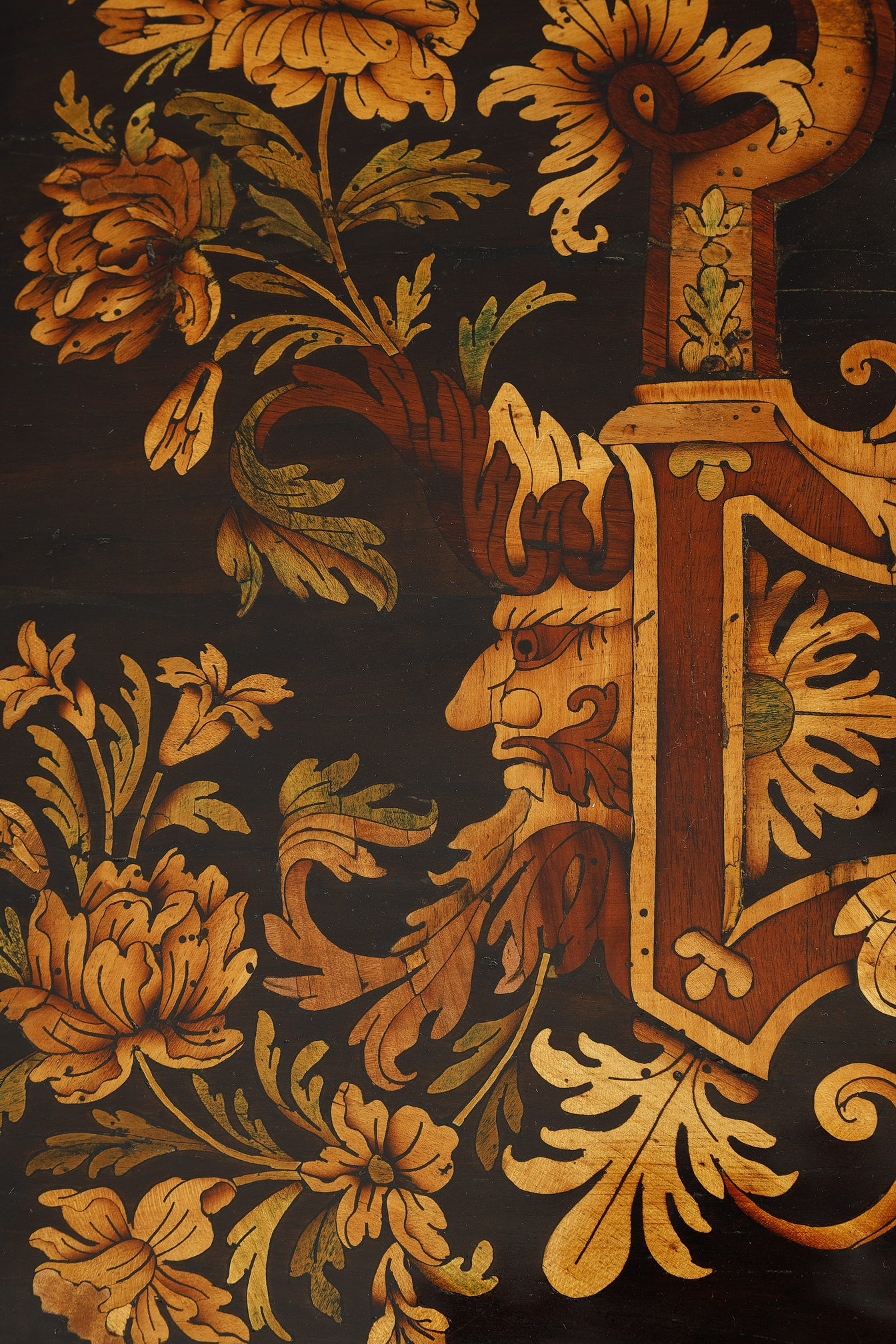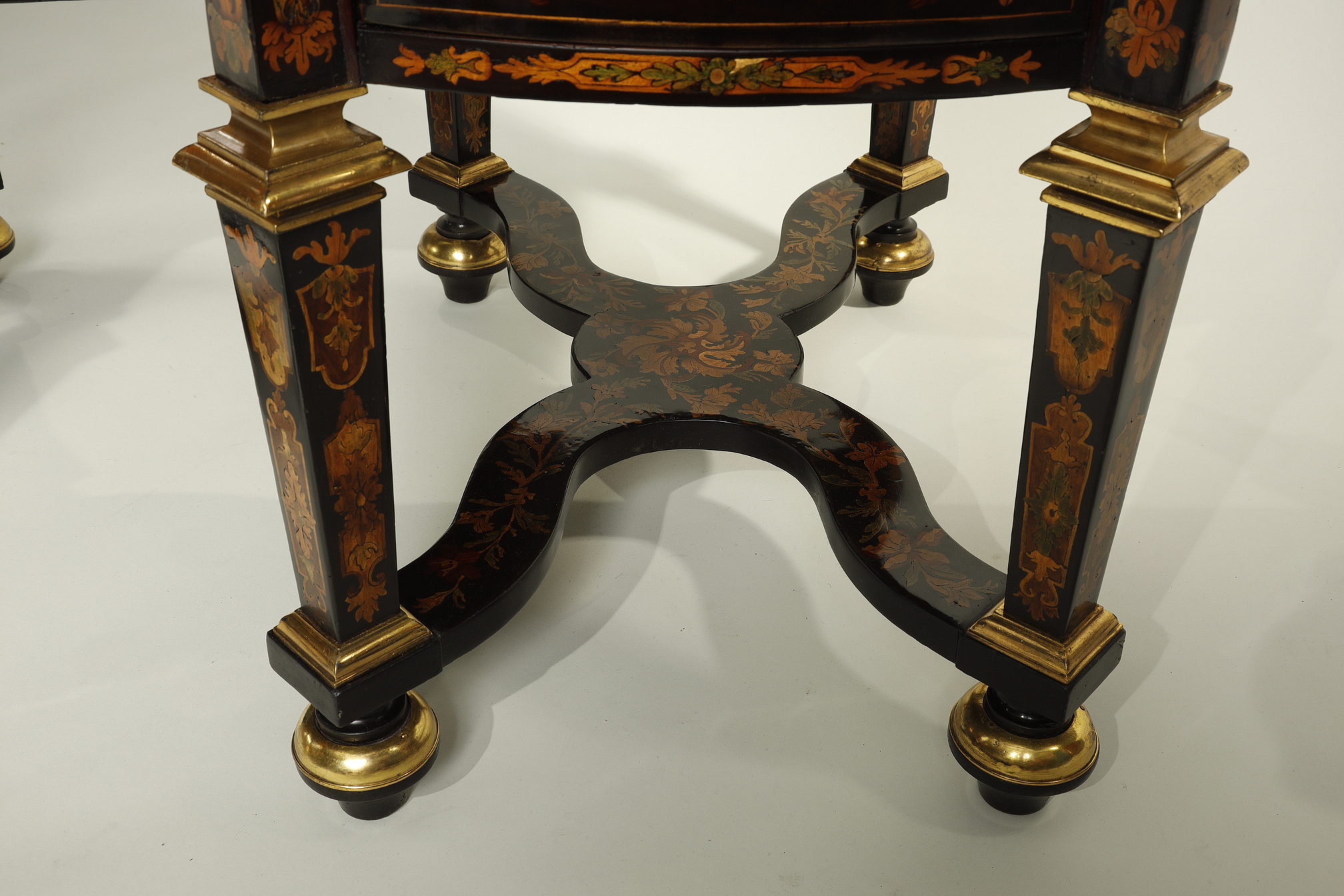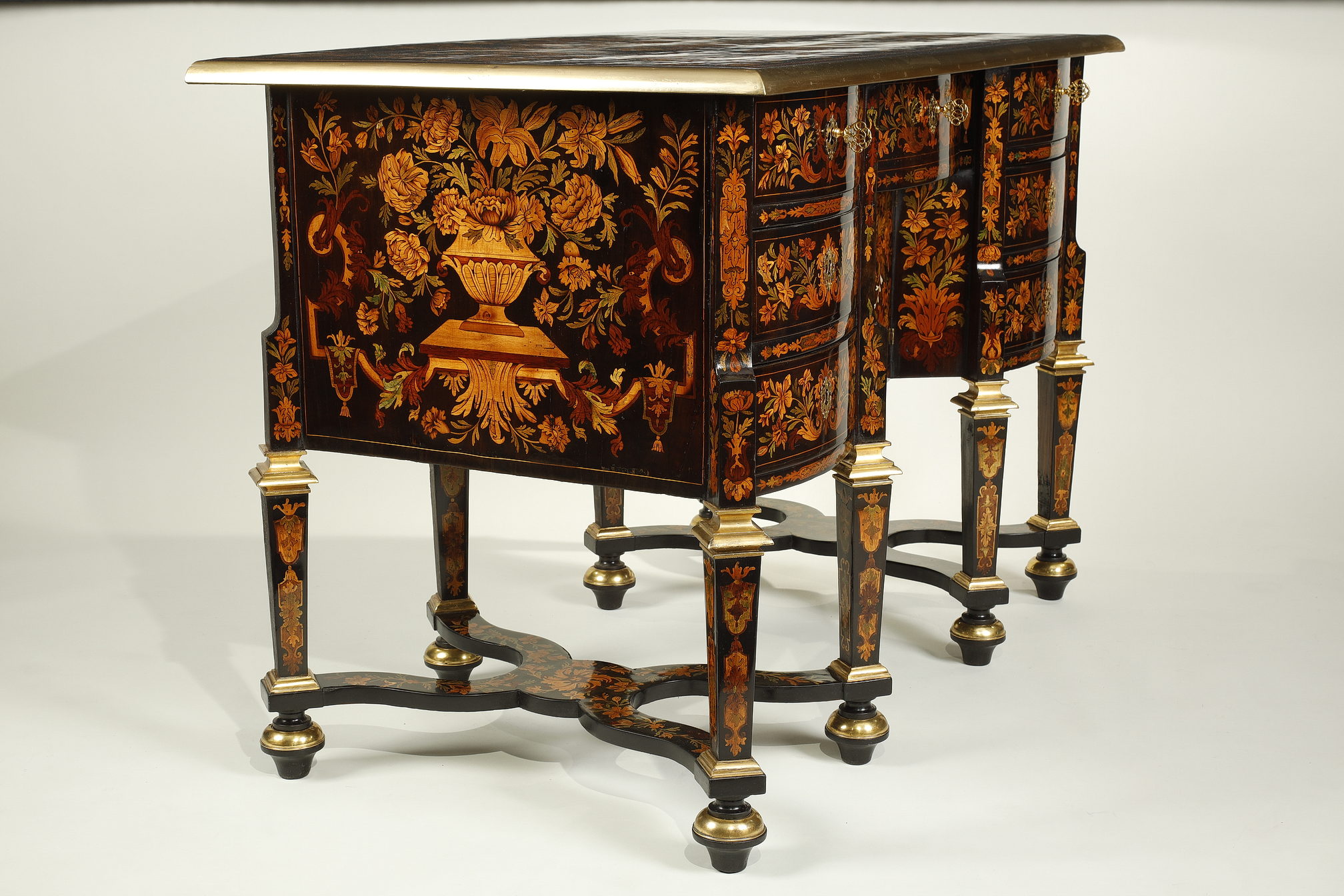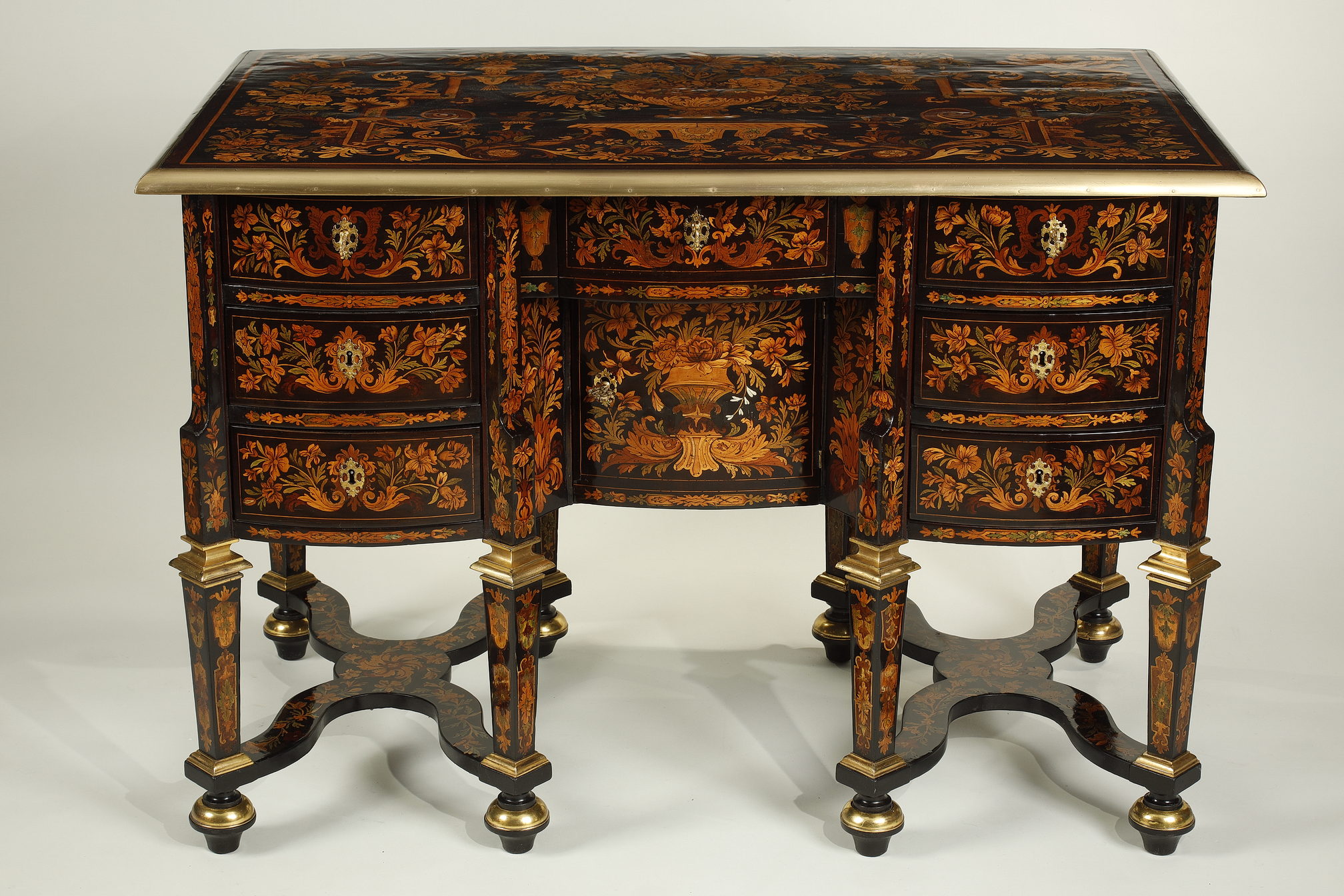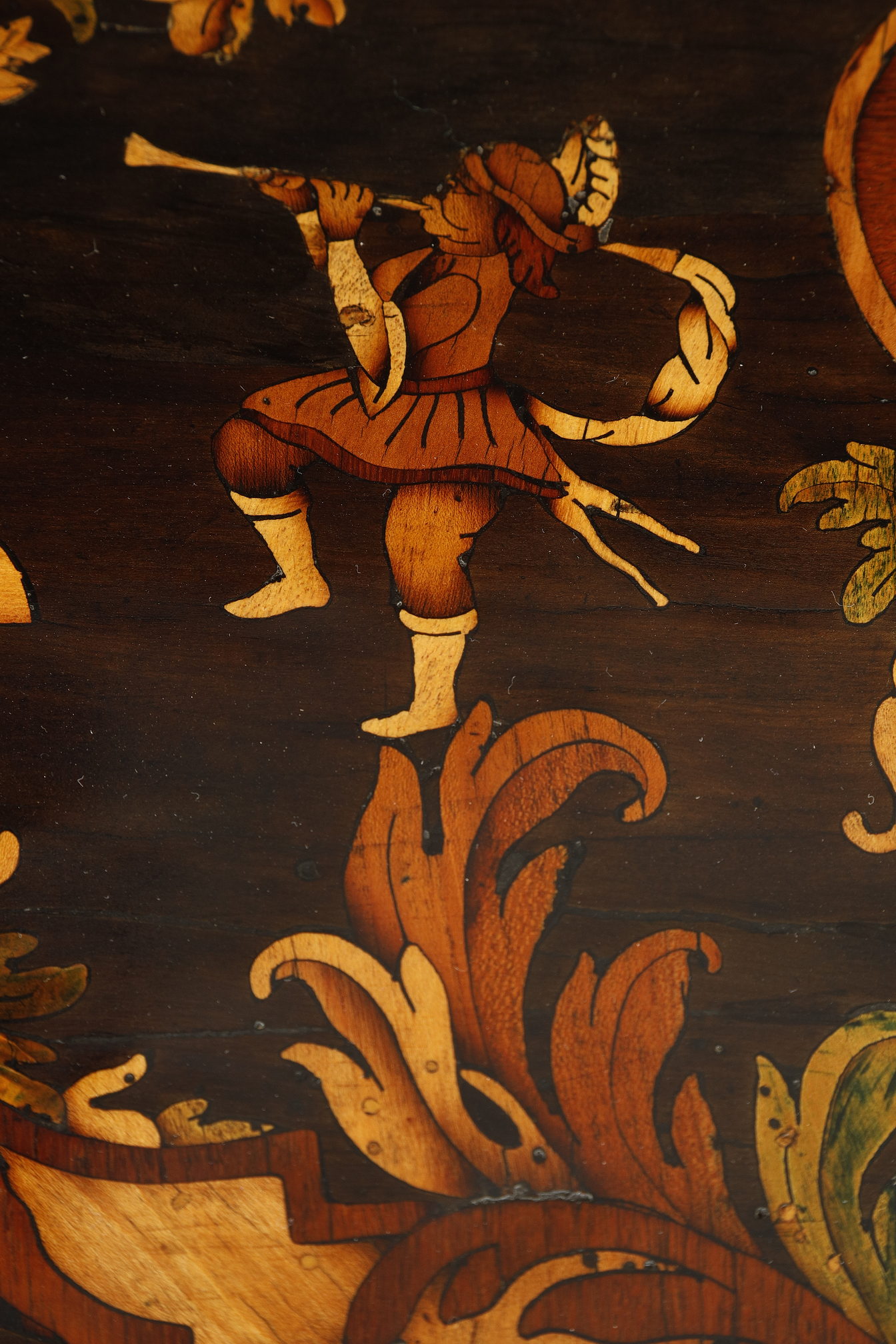Description
Mazarin Desk, Around 1700, Attributed To Renaud Gaudron
Dimensions: 82 cm high; 118cm wide; 69cm deep
Desk with eight legs in the form of Mazarin in marquetry on an ebony background, the front opening with seven drawers and a window.
It is decorated throughout with floral and scrollwork motifs, the center is inlaid with an ornate vase on a scrollwork platform flanked by additional scrollwork and geometric designs interspersed with sphinxes, musicians playing the tambourine and the trumpet, rustic masks and putti with pewter inlays.
The sides also inlaid, above a frieze drawer and a toggle cupboard door inlaid with a sprig of ivory flowers, flanked by two rows of three drawers with gilt crests, separated by uprights with cut sides, on tapered square legs joined by two corrugated cross spacers. It rests on spinning feet.
This type of marquetry appeared as early as the 1670s on several types of furniture fashionable at that time. These include chests, cabinets and desks known as Mazarin, notably made by the cabinetmaker Pierre Gole.
Renaud Gaudron (died 1727), Crown cabinetmaker from 1686.
Son of Aubertin Gaudron, master cabinetmaker in Paris and ordinary cabinetmaker to the Duchess Palatine, and Suzanne Valet, Renaud, also known as Gaudron the Younger, was born around 1653, being the last boy of eleven siblings.
With his eldest Nicolas (circa 1651-1702), he completed his training as a cabinetmaker in his father’s workshop, becoming a master before 1684 and this year replaced his father as ordinary cabinetmaker to Elisabeth-Charlotte of Bavaria, Duchess d’Orléans, then entered the service of the Royal Furniture Guard, sometimes associated with his brother established in Versailles.
He had made a specialty of furniture covered with antique wood marquetry and the Journal du Garde Meuble records his many deliveries of tables, desks and chests of drawers, the tops of which are often decorated with vases of flowers placed on a table or on a campane, with birds, butterflies, small grotesque figures or sphinxes, motifs that have made it possible to attribute to it a certain number of pieces of furniture still preserved (Demetrescu, 2000).
He delivers, among other things, one of the two monumental wardrobes made for the King in Marly, the other being made later by André-Charles Boulle.
Renaud Gaudron is undoubtedly the author of the pair of chests of drawers from the furnishing of the Grand Dauphin mentioned, forming part of the Spanish royal collections, and we can also attribute to him the chest of drawers in the Cluny museum, all of which present certain similarities in decor with our chest of drawers.
Moreover, several of these motifs are found on other pieces attributed to Renaud Gaudron and evoke the composition of the top of a chest of drawers, of slightly larger dimensions and with three drawers, delivered by the cabinetmaker in 1713 for the castle. from Compiègne: it was covered with wooden marquetry of several colors on an ebony background, decorated in the middle with a vase filled with flowers placed on a end of a table and a grotesque mask below; the rest filled with natural foliage, flowers, birds and butterflies, all enclosed by three nets of white wood, etc.
This desk belongs to a group of furniture executed between 1685 and 1710, which can be linked with great likelihood to the creation of Renaud Gaudron (c.1653-1727), cabinetmaker of the Garde Meuble de la Couronne and its main provider of furniture with report’s wood marquetry, from 1686 until 1713.
Very similar in appearance and with few variations in their decoration, certain motifs of which recur repeatedly, they reveal that they belong to the production of the same cabinetmaker’s workshop. All are equipped with straight uprights, arranged at 45°, tops with rounded or cut corners. The trays are invariably decorated in the middle with a vase of flowers placed on an entablature, below which is a head of a leafy mascaron, all surrounded by an abounding motif of volutes and acanthus scrolls whose windings towards the two other small bulb-shaped flower vases emerge from the ends.
The motif representing the large rosette surmounted by an acanthus fleuron serving as a support for a bouquet of flowers is common to the side panels of a pair of chests of drawers barely older, executed for Louis, Grand Dauphin of France and bearing his monogram. , from the furniture of King Philip V of Spain as well as those of another chest of drawers from the years 1700-1710, of a different model with its front simulating nine drawers arranged in three rows and with its rounded uprights.
ATTRIBUTION
All the furniture mentioned so far is adorned with fairly similar decorations, some of which are reminiscent of the influence of Boullian models.
Moreover, the reminder of certain motifs used by André-Charles Boulle for his wood marquetry is felt, especially when it comes to the leafy mascaron, sometimes crowned with Indian-style feathers, sometimes with a shell. with wide grooves, or a palmette.
However, the motifs and the composition of the decoration used on a group of chests of drawers, as well as on all the pieces mentioned so far, remain quite different from the flower marquetry used by André-Charles Boulle on furniture undoubtedly from his workshop; and this, although we have sometimes tried to suggest the connection between this production and that of this cabinetmaker.
Thus, a first chest of drawers with the motifs of our office was registered in the Garde Meuble de la Couronne on October 28, 1695, delivered by Gaudron for the service of the Château de Marly and entered in the General Inventory under number 487. But, in fact, it is Renaud Gaudron, who became the main supplier of furniture for the royal houses from June 8, 1686, replacing Pierre Gole, who also died in 1684.
On November 10, 1688, the Garde-meuble de la Couronne received the delivery of two desks for the apartments of Madame de Maintenon at the Palace of Versailles. Calin Demetrescu in his reference work, The cabinetmakers of the Crown under the reign of Louis XIV, Lausanne, 2021, p.178-179, transcribes the mention of the Journal du Garde-meuble de la Couronne as follows: « from wood marquetry to report flowers each having seven drawers and a lockable cupboard in the middle, whose keyholes are of gilded bronze, above is represented a vase full flowers on a waiting table with birds and butterflies, carry by eight pillars in term with bazes and golden balls”.
This delivery belongs to an important group of furniture delivered by Renaud Gaudron (probably with the collaboration of his brother Nicolas) from 1684, when he obtained a virtual monopoly of cabinet-making supplies from the Garde-meuble de la Couronne .
The piece of furniture presented, as well as this description, correspond to a relatively precise decorative typology today invariably attributed to Renaud Gaudron (born around 1653, cabinetmaker received master before 1784 and died in 1727).
Although several workshops distinguished themselves at the same time in the field of timber marquetry, today we directly associate the Gaudrons with a certain figurative exuberance associated with the motifs of large acanthus leaves, entablatures and vases of flowers. This abundance of details is however condensed around a recurring syntax composed of leafy mascarons, grotesque profiles, birds and butterflies. Later, at the very end of the 17th century, other figures probably appear to complete the previous ones; these include sphinxes, which are then associated with the cabinetmaker’s usual repertoire.




















